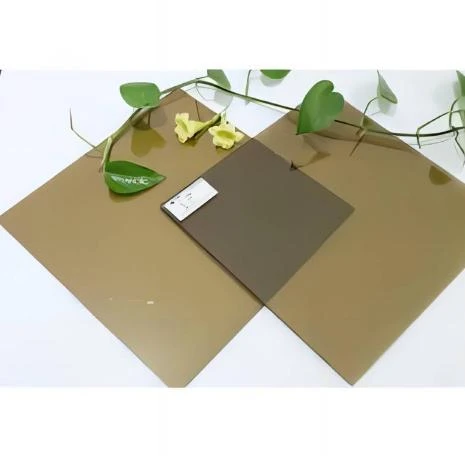The Versatility and Aesthetics of Tinted Glass A Comprehensive Overview
Tinted glass has become an indispensable material in modern architecture and design, offering a perfect blend of aesthetics, functionality, and energy efficiency. This specially treated glass serves many purposes, from enhancing privacy to controlling solar heat gain, making it an increasingly popular choice in residential, commercial, and even automotive applications.
What is Tinted Glass?
Tinted glass is produced by adding metal oxides or colorants during the manufacturing process. This results in a glass that has a uniform coloration, which can vary from subtle hues to more pronounced shades depending on the type and concentration of the tint. The tinting can be applied to various types of glass, including float glass, tempered glass, and laminated glass, making it a versatile option for numerous applications.
Aesthetic Appeal
One of the primary reasons architects and designers choose tinted glass is its aesthetic value. Tinted glass can transform the appearance of a building, creating an impactful visual statement. With a wide range of colors available, from deep blues and greens to soft grays and bronzes, architects can select tints that complement their designs and enhance the overall appearance of a structure. Moreover, tinted glass can create a cohesive look when used consistently across a project, contributing to the building's identity and character.
Energy Efficiency
In addition to its aesthetic benefits, tinted glass plays a significant role in improving energy efficiency. By reducing the amount of solar heat entering a building, tinted glass helps maintain a comfortable indoor temperature. This is particularly advantageous in warmer climates, where excessive heat gain can lead to increased reliance on air conditioning systems. With less heat entering the space, building owners can save on energy costs and reduce their carbon footprint, contributing to a more sustainable future.
tinted glass material
Furthermore, many tinted glass products are designed to block a significant percentage of ultraviolet (UV) radiation. UV rays can cause fading in interior furnishings, fabrics, and artworks, leading to premature deterioration. Tinted glass helps mitigate this damage, preserving the longevity and appearance of valuable interior items.
Privacy and Security
Another significant advantage of tinted glass is the enhanced privacy it provides. Depending on the darkness of the tint, tinted glass can obscure visibility from the outside while still allowing natural light to enter. This is particularly useful in urban settings, where buildings are in close proximity, and residents or office workers may seek to maintain their privacy without sacrificing daylight. Additionally, tinted glass can enhance security; darker tints make it harder to see inside, potentially deterring unwanted attention.
Selection Considerations
When selecting tinted glass for a project, several factors should be taken into account. First, the local climate and orientation of the building play critical roles in determining the appropriate level of tint. For instance, a building with a southern exposure may benefit from a darker tint to combat excessive sunlight, while a north-facing facade may require a lighter tint to allow for natural light.
Next, it is essential to consider the building’s overall design and the desired aesthetic. Different tints can drastically change the look of a facade, so careful selection is key to achieving the desired effect. Finally, compliance with local building codes and regulations is vital, especially in commercial applications, where specific performance standards for tinted glass may apply.
Conclusion
In conclusion, tinted glass is a multifaceted material that enhances functional, aesthetic, and environmental aspects of buildings. Its ability to provide privacy, energy efficiency, and aesthetic appeal makes it a wise choice for various applications. As trends in architecture continue to evolve, tinted glass will remain a popular and practical option for designers and builders alike, proving that this classic material is far from outdated. Whether it’s a residential renovation or a cutting-edge commercial project, tinted glass offers solutions that not only look stunning but also contribute to a greener planet.
 Afrikaans
Afrikaans  Albanian
Albanian  Amharic
Amharic  Arabic
Arabic  Armenian
Armenian  Azerbaijani
Azerbaijani  Basque
Basque  Belarusian
Belarusian  Bengali
Bengali  Bosnian
Bosnian  Bulgarian
Bulgarian  Catalan
Catalan  Cebuano
Cebuano  Corsican
Corsican  Croatian
Croatian  Czech
Czech  Danish
Danish  Dutch
Dutch  English
English  Esperanto
Esperanto  Estonian
Estonian  Finnish
Finnish  French
French  Frisian
Frisian  Galician
Galician  Georgian
Georgian  German
German  Greek
Greek  Gujarati
Gujarati  Haitian Creole
Haitian Creole  hausa
hausa  hawaiian
hawaiian  Hebrew
Hebrew  Hindi
Hindi  Miao
Miao  Hungarian
Hungarian  Icelandic
Icelandic  igbo
igbo  Indonesian
Indonesian  irish
irish  Italian
Italian  Japanese
Japanese  Javanese
Javanese  Kannada
Kannada  kazakh
kazakh  Khmer
Khmer  Rwandese
Rwandese  Korean
Korean  Kurdish
Kurdish  Kyrgyz
Kyrgyz  Lao
Lao  Latin
Latin  Latvian
Latvian  Lithuanian
Lithuanian  Luxembourgish
Luxembourgish  Macedonian
Macedonian  Malgashi
Malgashi  Malay
Malay  Malayalam
Malayalam  Maltese
Maltese  Maori
Maori  Marathi
Marathi  Mongolian
Mongolian  Myanmar
Myanmar  Nepali
Nepali  Norwegian
Norwegian  Norwegian
Norwegian  Occitan
Occitan  Pashto
Pashto  Persian
Persian  Polish
Polish  Portuguese
Portuguese  Punjabi
Punjabi  Romanian
Romanian  Russian
Russian  Samoan
Samoan  Scottish Gaelic
Scottish Gaelic  Serbian
Serbian  Sesotho
Sesotho  Shona
Shona  Sindhi
Sindhi  Sinhala
Sinhala  Slovak
Slovak  Slovenian
Slovenian  Somali
Somali  Spanish
Spanish  Sundanese
Sundanese  Swahili
Swahili  Swedish
Swedish  Tagalog
Tagalog  Tajik
Tajik  Tamil
Tamil  Tatar
Tatar  Telugu
Telugu  Thai
Thai  Turkish
Turkish  Turkmen
Turkmen  Ukrainian
Ukrainian  Urdu
Urdu  Uighur
Uighur  Uzbek
Uzbek  Vietnamese
Vietnamese  Welsh
Welsh  Bantu
Bantu  Yiddish
Yiddish  Yoruba
Yoruba  Zulu
Zulu 

